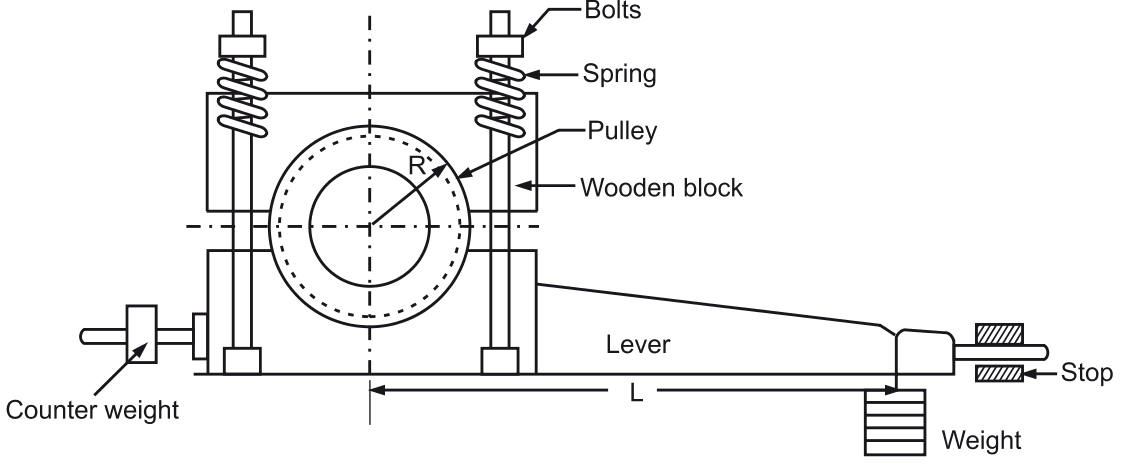A Prony Brake Dynamometer is a simple mechanical device used to measure the power output of an engine or motor by absorbing energy through friction. It is one of the oldest types of dynamometers and operates by applying friction to a rotating shaft and measuring the resulting force.

Construction of Prony Brake Dynamometer
The Prony Brake Dynamometer consists of the following components:
- Pulley (or Brake Drum): A rotating drum connected to the engine or motor shaft.
- Wooden Block (Friction Surface): A wooden block is placed around the drum to create friction.
- Bolts & Springs: Used to tighten the wooden blocks around the drum.
- Lever Arm: A rigid arm attached to the brake system that extends outward.
- Counterweight: A weight on one side of the lever arm to balance the system.
- Load Weight: A hanging weight at the end of the lever arm that provides torque.
- Stop: A fixed support that prevents excessive movement of the lever arm.
Working Principle of Prony Brake Dynamometer
The working of the Prony Brake Dynamometer is based on the principle of frictional resistance and torque measurement. The process is as follows:
- The engine or motor rotates the pulley (brake drum).
- The wooden blocks press against the rotating drum due to the bolts and springs, generating friction.
- This frictional force applies torque on the lever arm.
- A counterweight balances the system, and a separate weight at the end of the lever arm provides the required force.
- The torque is measured by multiplying the force exerted by the weight and the lever arm length.
- The power output of the engine is then calculated using the torque and rotational speed.
Mathematical Derivation
To determine the \textbf{brake power (BP)} of the engine, we use the following formulas:
Torque Calculation
The torque exerted by the system is given by:
\[T = W \times L\]
\( T \) = Torque (N·m)
\( W \) = Load weight (N)
\( L \) = Length of the lever arm (m)
Brake Power Calculation
The power absorbed by the dynamometer is given by:
\[BP = \frac{2\pi N T}{60}\]
where:
\( BP \) = Brake Power (Watts or kW)
\( N \) = Rotational speed of the shaft (RPM)
\( T \) = Torque (N·m)
If converted to horsepower (HP):
\[BP (HP) = \frac{2\pi N T}{4500}\]
Advantages of Prony Brake Dynamometer
- Simple Construction: It is easy to construct and does not require complex mechanisms.
- Cost-Effective: The materials required for construction are inexpensive and readily available.
- Direct Measurement: It provides direct measurement of torque and power.
- Portable: It is lightweight and can be moved easily.
- No Need for Electrical Components: Unlike other types of dynamometers, it does not require electronic sensors or power sources.
Applications of Prony Brake Dynamometer
- Engine Testing: Used to test the power output of internal combustion engines.
- Small Motor Testing: Suitable for measuring the performance of small electric motors.
- Educational Purposes: Commonly used in engineering laboratories for teaching mechanical power measurement.
- Research & Development: Used in R&D departments to analyze frictional losses in rotating systems.
- Agricultural Machinery: Utilized for testing the power output of tractors and other farm machinery.
Disadvantages of Prony Brake Dynamometer
- Heat Generation: Friction produces a significant amount of heat, which can lead to overheating.
- Wear & Tear: Continuous use causes wear of the wooden blocks, requiring frequent maintenance.
- Limited Load Capacity: Not suitable for high-power engines due to frictional limitations.
- Manual Adjustments: Requires manual tightening and adjustment, leading to inconsistency in measurements.
- Inefficiency: Energy is wasted as heat instead of being converted into useful work.
Conclusion
The Prony Brake Dynamometer is a fundamental device for measuring power output in engines and rotating machinery. Its simplicity, affordability, and effectiveness make it a valuable tool for testing and educational purposes. However, its drawbacks, such as heat generation and frequent wear, limit its applications in high-power scenarios. Despite its limitations, it remains a useful and practical tool in mechanical engineering.